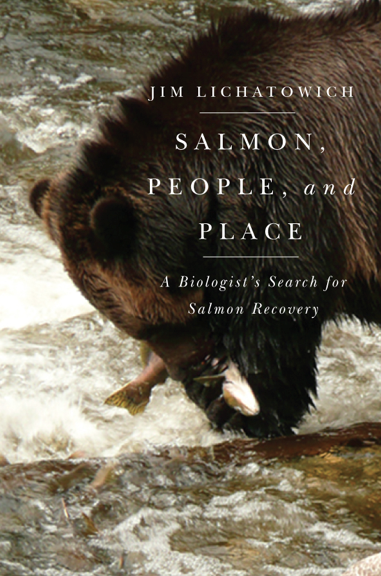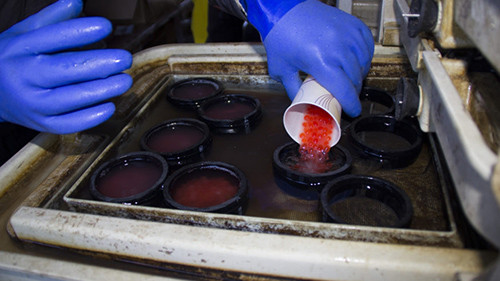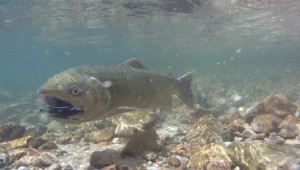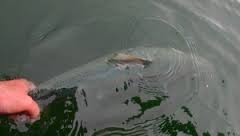Source: OPB.org
In the late 1800s, when dams were first built around the Northwest, salmon and steelhead stocks began to decline. Fish hatcheries were put forth as a solution. Wild fish were taken from Northwest rivers and spawned in captivity, ensuring future generations of fish could be released back into the wild every season.
Jim Lichatowich is a biologist who’s worked on salmon issues as a researcher, manager and scientific advisor for more than 40 years. He sat down with EarthFix’s Ashley Ahearn to talk about his new book: “Salmon, People and Place: A Biologist’s Search For Salmon Recovery.”
Ashley Ahearn: For someone who doesn’t know what a hatchery is or doesn’t understand how it operates, what happens at a hatchery?
Jim Lichatowich: Fundamentally at a hatchery, salmon are taken out of the river, put into ponds until they’re ready to spawn and then the eggs are taken. They’re fertilized. Various different procedures are used at different hatcheries but that’s basically it. The eggs hatch, the juveniles are reared in the hatchery for varying levels of time and then they’re released back to the river and expected to migrate downstream fairly rapidly and go out to the ocean and from that point on pick up the normal life history of a regular wild salmon.

I guess the idea of how hatcheries started and [what] sustained them was, habitat was degrading and the fish weren’t doing as well in the degraded habitat. So the hatchery became a solution, a way of circumventing the problems we were creating ourselves by building dams, pumping out irrigation water, poor forestry practices that put silt and sawdust into the streams. The hatchery was supposed to take the salmon away from that problem, circumvent the problem.
Ashley Ahearn: Jim you talk about the ‘machine metaphor’ for nature. What is that? Can you read a section from your book here?
Jim Lichatowich: Sure I’ll read where I talk about the machine metaphor and the fish factory. And I might add here that I use ‘fish factory’ instead of hatchery through a large part of the book because that’s what hatcheries were originally called when they were first being used. They were called ‘pisce factories,’ or fish factories.
“The fish factory and the machine metaphor are a perfect match. The mechanistic worldview reduced salmon-sustaining ecosystems to an industrial process and rivers to simple conduits whose only function was to carry artificially-propagated salmon to the sea. The mechanistic worldview still has a powerful grip on salmon management and restoration programs in spite of a growing scientific understanding that the picture of ecosystems created by the machine metaphor was seriously flawed.”
And really, it’s been the factory metaphor that has guided a lot of the operation of hatcheries.
Ashley Ahearn: One of the things I really liked about your book is these side channel chapters that you sprinkle in between some pretty heavy critique of the way we manage our fisheries in this region. One of your side channels that I particularly liked was when you write about a trip to Indiana to the St. Joe River. Tell me about that side channel.
Jim Lichatowich: Well I grew up outside of South Bend, Indiana and the St. Joe River flows through South Bend. When I grew up there the St. Joe was pretty much a sewer that didn’t have much in the way of fish life. And over the years, particularly since I left — I left there in the 60s — there’d been a lot of clean up. And with the introduction of salmon into Lake Michigan — the St. Joe flows into Lake Michigan — they built a salmon hatchery and had a Chinook salmon run up the St. Joe River. They had to build a hatchery and clean the river up, too.
I was there and I was walking along the river and I came to where a tributary came into the St. Joe, and there was a salmon carcass — a Chinook salmon carcass laying up on the bank of the stream — and it just struck me how out of place it was. Seeing carcasses along rivers is pretty common here, but in Indiana that was a sight. And later on in watching the river, I saw salmon trying to spawn and I knew that their spawning was not going to be successful because the gravel was so silted in that the eggs weren’t going to get oxygen. I talked to a biologist a couple of days later and they confirmed that there’s very little or no actual reproduction, even though there are fish out there spawning.
I thought, you know, this really robs the salmon of their whole heroic story of battling up stream to get to the place where they spawned and where they could complete the cycle of parent to offspring. Even though it’s looked on by sportsmen in Northern Indiana as a positive thing, and there were a lot of people fishing for these fish that were in the river, I somehow had this nagging feeling that ‘should we be doing this to other species? Should we take them from where they belong and put them in a place where they have no chance of surviving without our intervention in a hatchery and call it salmon management?’
Ashley Ahearn: Is that what is happening here in the Northwest? I mean, we have salmon. The salmon have lived here for thousands of years — it’s not like Indiana, but arguably it’s a similar closed … are we robbing the salmon of their story here in the Northwest?
Jim Lichatowich: Well when we rely on hatcheries instead of healthy rivers, then we are robbing them of part of their story. Fortunately most of the rivers in the Northwest can support some wild production, some more than others.
But by relying more and more on hatcheries we’re creating a charade of sorts where the river that can’t support a salmon becomes a stage prop where fishermen and fish play out their respective roles, reenacting something, an important part of our past, that now is sort of a hollow empty memory of it.
Ashley Ahearn: Jim from your perspective are all hatcheries bad? Is there a good hatchery?
Jim Lichatowich: I think there might be, but the answer to that question hasn’t been answered. There has been attempts to reform hatcheries in the past and they haven’t been successfully implemented. There is a lot of good science now that should help managers change the way hatcheries are being operated to begin to see if they can begin to be integrated into a natural production system in a watershed. But it remains to be seen whether that will actually happen.
Ashley Ahearn: So if you were in charge, what needs to happen? What would be your order of operations to get salmon recovery back on track in this region?
Jim Lichatowich: Well I have two kind of strong ideas and those strong ideas were what I followed in writing this book. One was from John Livingston who said that all environmental problems, and I take that to mean salmon problems, are like icebergs, because, like an iceberg, environmental problems have a visible tip and for the salmon that tip is dams, over harvest, poor hatchery practice, poor logging practice –- the litany of things that we’re all aware of. But he says in addition there’s this huge hidden mass that an iceberg has. In that mass he calls it, he says in that mass there are the myths, beliefs and assumptions about how nature works that drive the decisions that either create the issues or prevent them from being corrected. And I think that’s a pretty powerful idea. We need to examine that body of myths, assumptions and beliefs. What I call in my book, our salmon story, and improve upon it. Make sure it reflects the latest science and not some really outdated myths or beliefs.
Ashley Ahearn: Or machine metaphors.
Jim Lichatowich: Or machine metaphors, right. And the other is Gary Nabhan’s idea. In one of his books he says that animals don’t go extinct because someone shoots the last one, or a bulldozer scrapes the last habitat. They go extinct because the web of relationships that sustain them unravels. He then put it in anthropomorphic terms and said, they go extinct because of a lack of ecological companionship. I think that idea is intuitive but at the same time very powerful. It should lead us to instead of defining the salmon’s problem in terms of numbers, which is really limiting your definition to the symptoms, it would be defined in terms of the unraveling of those relationships. And recovery, instead of boosting numbers by releasing more hatchery fish, would be a mending of those relationships. Trying to re-institute those relationships, and that’s a different approach than what we’ve been doing.
Ashley Ahearn: It seems your solutions center around a fundamental philosophical shift that needs to happen in the way we view management.
Jim Lichatowich: That’s right, and that is a good summary of my purpose in this book, is to make an argument for that shift.
Jim Lichatowich is the author of “Salmon, People and Place: A Biologist’s Search For Salmon Recovery.”










